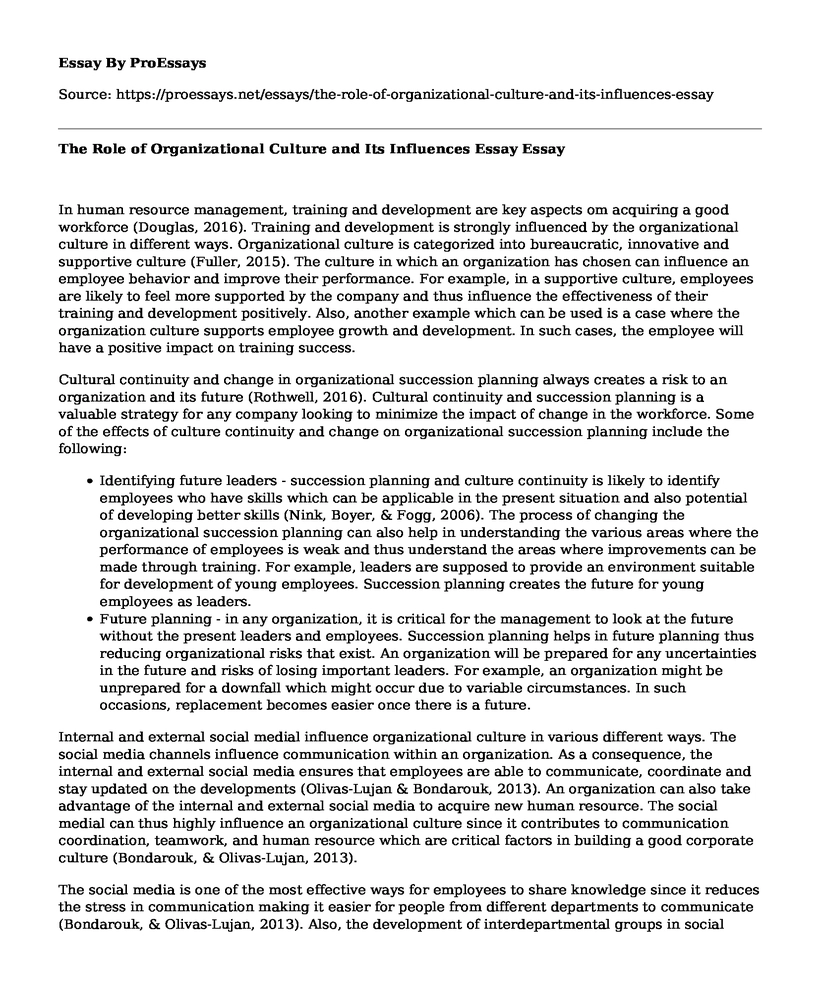In human resource management, training and development are key aspects om acquiring a good workforce (Douglas, 2016). Training and development is strongly influenced by the organizational culture in different ways. Organizational culture is categorized into bureaucratic, innovative and supportive culture (Fuller, 2015). The culture in which an organization has chosen can influence an employee behavior and improve their performance. For example, in a supportive culture, employees are likely to feel more supported by the company and thus influence the effectiveness of their training and development positively. Also, another example which can be used is a case where the organization culture supports employee growth and development. In such cases, the employee will have a positive impact on training success.
Cultural continuity and change in organizational succession planning always creates a risk to an organization and its future (Rothwell, 2016). Cultural continuity and succession planning is a valuable strategy for any company looking to minimize the impact of change in the workforce. Some of the effects of culture continuity and change on organizational succession planning include the following:
- Identifying future leaders - succession planning and culture continuity is likely to identify employees who have skills which can be applicable in the present situation and also potential of developing better skills (Nink, Boyer, & Fogg, 2006). The process of changing the organizational succession planning can also help in understanding the various areas where the performance of employees is weak and thus understand the areas where improvements can be made through training. For example, leaders are supposed to provide an environment suitable for development of young employees. Succession planning creates the future for young employees as leaders.
- Future planning - in any organization, it is critical for the management to look at the future without the present leaders and employees. Succession planning helps in future planning thus reducing organizational risks that exist. An organization will be prepared for any uncertainties in the future and risks of losing important leaders. For example, an organization might be unprepared for a downfall which might occur due to variable circumstances. In such occasions, replacement becomes easier once there is a future.
Internal and external social medial influence organizational culture in various different ways. The social media channels influence communication within an organization. As a consequence, the internal and external social media ensures that employees are able to communicate, coordinate and stay updated on the developments (Olivas-Lujan & Bondarouk, 2013). An organization can also take advantage of the internal and external social media to acquire new human resource. The social medial can thus highly influence an organizational culture since it contributes to communication coordination, teamwork, and human resource which are critical factors in building a good corporate culture (Bondarouk, & Olivas-Lujan, 2013).
The social media is one of the most effective ways for employees to share knowledge since it reduces the stress in communication making it easier for people from different departments to communicate (Bondarouk, & Olivas-Lujan, 2013). Also, the development of interdepartmental groups in social medial channels such as WhatsApp and Telegram have made it easier for departments to brainstorm on various issues without having to call for a physical meeting (Bondarouk, & Olivas-Lujan, 2013). Additionally, some employees find it easier to open up on issues via social media in comparison to one on one communication. The social media is thus the best and most effective way for employees to share knowledge.
References
Bondarouk, T., & Olivas-Lujan, M. R. (2013). Social media in strategic management. Bingley, UK: Emerald Group Publishing Limited.
Douglas, A. (2016). Training and development in performance management. Human Resources Magazine, 21(2), 37-38.
Fuller, C. P. (2015). Organizational culture: leadership strategies, outcomes and effectiveness. New York: Nova Science Publishers, Inc.
Nink, C., Boyer, D., & Fogg, J. (2006). Succession planning: Preparing future corrections leaders. Corrections Today, 68(5), 34-37.
Olivas-Lujan, M. R., & Bondarouk, T. (2013). Social media in human resources management. Bingley, U.K.: Emerald Group Publishing Limited.
Rothwell, W. J. (2016). Effective succession planning: ensuring leadership continuity and building talent from within. New York: AMACOM.
Cite this page
The Role of Organizational Culture and Its Influences Essay. (2022, Apr 14). Retrieved from https://proessays.net/essays/the-role-of-organizational-culture-and-its-influences-essay
If you are the original author of this essay and no longer wish to have it published on the ProEssays website, please click below to request its removal:
- Course Work Example: Communication in the Workplace
- Paper Example on Modern Rangers: Ethics and Leadership
- Effective Leadership Characteristics Essay Example
- Strategies of Cultural Competence to Nurses Essay Example
- Paper Example on Clinical Decisions: Management Issues and Challenges
- Essay Example on Shareholder Rights & Privileges: Key to Stock Valuation
- Critical Thinking and Creative Problem-Solving: 8 Elements of Thought - Essay Sample







